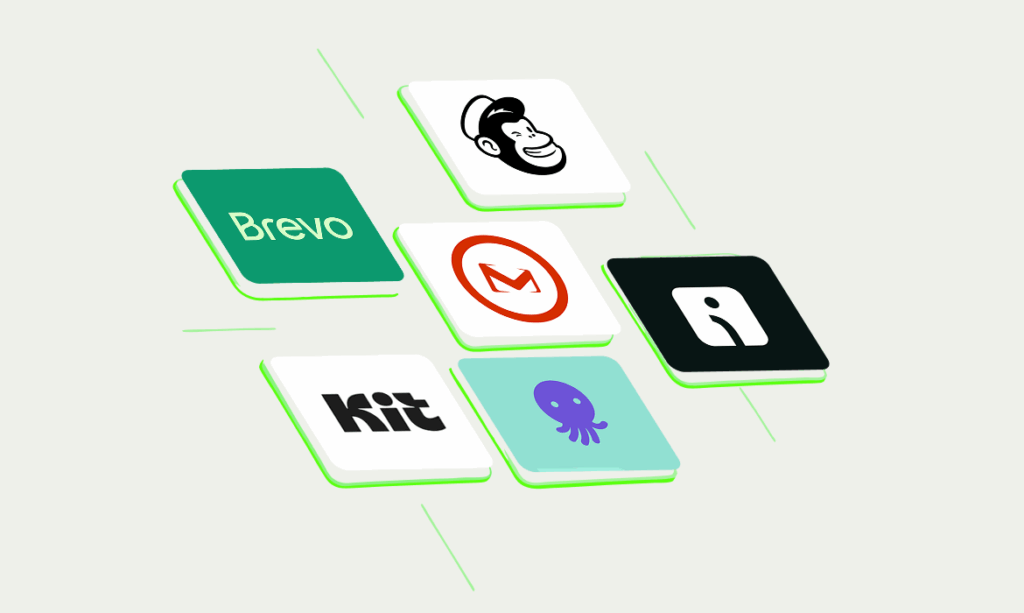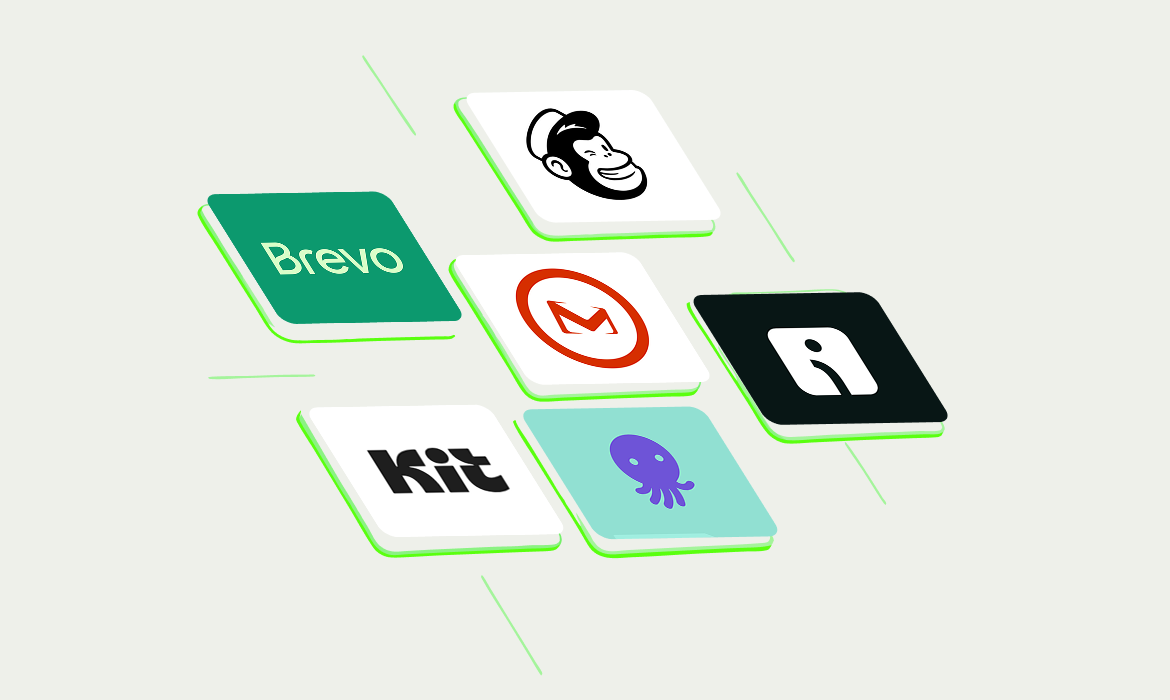
Email marketing offers a staggering 3600% ROI, making the best email marketing platforms 2025 has to offer essential tools for business growth. That’s right—businesses earn $36 for every dollar spent on email campaigns.
Despite these impressive returns, finding the right email marketing platform doesn’t have to break the bank. Many free email marketing tools provide unlimited emails and subscribers, perfect for small business owners just getting started. Some even include premium features like landing pages, automation, and transactional emails typically reserved for paid plans. Fortunately, several platforms offer generous free options — Kit allows unlimited sends for up to 10,000 subscribers, while MailerLite provides 12,000 monthly emails for up to 1,000 contacts.
Table of Contents
The email marketing landscape is changing rapidly. Mailchimp, once the leader in free services, now caps its free plan at just 1,000 emails monthly. Meanwhile, HubSpot lets you store up to 1,000,000 contacts and send 2,000 emails per month at no cost. With approximately 4 billion email users worldwide, we’ve tested and compared the top platforms to help you make the best choice for your business in 2025.
Emercury.net
Emercury stands out among the best email marketing platforms 2025 by focusing on deliverability and personalized support. This platform combines sophisticated features with an intuitive interface, making it particularly appealing for marketers seeking high engagement rates.
Emercury key features
Emercury’s platform centers around making email automation accessible while delivering powerful capabilities:
- Advanced Email Automation – Create profitable marketing funnels with multi-step journeys that nurture leads into customers. The journey builder is specifically designed to be intuitive, allowing users to build email sequences in seconds, even for beginners.
- Smart Personalization – Beyond basic merge tags, Emercury’s Smart Personalization lets entire sections of your email display differently based on subscriber conditions. Different subscribers see different content within the same campaign based on their profile data and behavior.
- Robust Segmentation – Group your audience based on almost any factor including behavior, preferences, and demographics. This targeted approach leads to higher engagement as contacts receive content they actually want.
- Comprehensive Analytics – Access detailed reporting on open rates, click-through rates, and subscriber engagement. The ECMP (Email Campaign Monitoring Performance) reports show exactly how much revenue you generate per subscriber.
- Managed Services – Unlike most platforms, Emercury offers hands-on expert assistance including email audit and strategy, automation mapping and setup, custom template design, and campaign management services.
- Deliverability Focus – Features like DMARC Record Generator, IP warm-up services, spam testing, and list cleaning ensure your emails reach the inbox consistently.
Emercury pros and cons
Pros:
- Exceptional Deliverability – The platform prioritizes inbox placement with advanced algorithms and dedicated delivery management.
- Personalized Support – Users gain access to dedicated marketing specialists who help set up campaigns and provide customized advice.
- User-Friendly Interface – The platform is designed to be intuitive and easy to navigate, particularly for beginners.
- High Engagement Rates – Users report open rates and engagement averaging around 20-25%, which is notably high for email marketing.
- Comprehensive Features – Almost all features are included even in lower-tier plans, with limits primarily based on volume rather than functionality.
Cons:
- Limited User Reviews – Fewer published user reviews compared to larger competitors, making it harder to evaluate the platform fully.
- Learning Curve – Advanced features may require time to explore and utilize effectively.
- Premium Pricing – Higher starting price point compared to some entry-level alternatives in the market.
Emercury pricing
Emercury offers three main pricing tiers:
| Plan | Starting Price | Contacts | Key Features |
| Grow | $275/month | Up to 49,999 | Automation, A/B testing, 50,000 email validations |
| Pro | $825/month | Up to 149,999 | Everything in Grow + dedicated IP, onboarding consultation |
| Scale | $1400/month | Unlimited | Everything in Pro + prioritized support, dedicated delivery analyst |
Emercury also offers a free forever plan for up to 12,000 monthly sends. Additionally, they provide a 15% discount for non-profits and a 10% discount for annual plans. Unlike many competitors, Emercury includes almost all features across all plans—you primarily pay for volume, not functionality. This means even lower-tier users get access to advanced segmentation, automation, and personalization features.
Emercury best use case
Emercury is particularly well-suited for:
- Entrepreneurs and Small Businesses – Especially those with multiple roles who need to save time through automation.
- Marketers Focused on Deliverability – For businesses where email deliverability directly impacts revenue, Emercury’s focus on inbox placement provides a significant advantage.
- Companies Needing Personal Support – The platform shines for those who value having direct access to email marketing experts rather than generic support.
- High-Volume Email Marketers – The platform scales effectively for businesses sending large campaigns while maintaining performance.
- Growing Ecommerce Businesses – With robust segmentation, ECPM revenue tracking, and upcoming specialized ecommerce features, Emercury provides the foundation for scaling online stores that prioritize email deliverability and customer lifetime value.
- Users Transitioning from Basic Tools – The intuitive interface makes it an excellent choice for those looking to upgrade from simpler email marketing solutions without facing a steep learning curve.
Furthermore, the platform excels at nurturing leads through personalized content, following up with relevant information, and preparing qualified customers through automated sequences.
Brevo
Brevo offers a versatile email marketing solution that balances functionality with affordability, making it one of the best email marketing platforms 2025 has available for growing businesses. Formerly known as Sendinblue, Brevo provides a comprehensive suite of tools beyond just email campaigns.
Brevo key features
Brevo distinguishes itself with a robust set of capabilities:
- Intuitive Email Builder – The drag-and-drop editor allows anyone to create professional-looking emails in minutes without design skills
- 99% Email Deliverability – Powerful infrastructure helps messages avoid the spam folder and reach subscribers’ inboxes
- AI-Powered Tools – Generate email content and subject lines with AI assistance, plus utilize predictive sending that optimizes delivery times based on individual open rates
- Multi-Channel Marketing – Beyond email, Brevo offers SMS, WhatsApp, web push notifications, and chat features
- Marketing Automation – Create workflow-based automations triggered by user behavior including welcome series, abandoned carts, and birthday messages
- Built-in CRM – Manage contacts, track deals, and maintain customer relationships all within the same platform
The platform also includes a comprehensive template library with 47 responsive designs organized by purpose rather than industry.
Brevo pros and cons
Pros:
- Free Plan Availability – Generous free tier allows 300 emails daily with unlimited contacts
- User-Friendly Interface – Clean dashboard design with helpful suggestions for beginners
- All-in-One Solution – Combines email, SMS, CRM, and automation in one platform
- Transactional Email Support – Includes SMTP relay service with 99.98% of emails delivered in under 20 seconds
- WordPress Integration – Plugin has over 80,000 active installations with 4.5-star rating
Cons:
- Daily Sending Limits – Free plan restricts to 300 emails per day
- Inconsistent Deliverability – Regular tests show deliverability isn’t always consistent
- Additional Costs – Features like removing Brevo branding require add-on purchases
- Limited Features in Lower Tiers – Advanced features like landing pages restricted to higher plans
- Credits Don’t Roll Over – Unused email credits in monthly plans don’t carry forward
Brevo pricing
Brevo structures pricing primarily based on email volume rather than contact count:
| Plan | Starting Price | Emails | Key Features |
| Free | $0 | 300/day | Basic templates, automation (limited), CRM |
| Starter | $9/month | 5,000/month | No daily limit, basic reporting, email support |
| Business | $18/month | 5,000/month | Unlimited automation, A/B testing, landing pages |
| Enterprise | Custom | Custom | Dedicated manager, advanced integrations, priority support |
Moreover, Brevo offers a pay-as-you-go option with credits that never expire, ideal for occasional senders.
Brevo best use case
Brevo works exceptionally well for:
- Small Businesses on Tight Budgets – The free plan and affordable starting tiers make it accessible for those just beginning with email marketing
- E-commerce Businesses – Features like abandoned cart emails, product purchase triggers, and SMS marketing create comprehensive customer journeys
- WordPress Website Owners – Seamless integration with WordPress makes setup nearly effortless
- Businesses Requiring Multi-Channel Communication – The combination of email, SMS, WhatsApp, and chat in one platform streamlines customer outreach
- Companies with Fluctuating Sending Needs – The pay-as-you-go option with non-expiring credits accommodates irregular sending patterns
In essence, Brevo serves as a cost-effective alternative to higher-priced platforms while still providing most essential marketing features.
Kit (formerly ConvertKit)
Kit (formerly ConvertKit) has emerged as one of the best email marketing platforms 2025 offers for content creators, with its creator-first approach setting it apart in the crowded email marketing landscape. In 2024, ConvertKit officially rebranded to “Kit” to reflect its expanding ecosystem beyond just email marketing.
Kit key features
Kit delivers several standout features tailored specifically for creators:
- Generous Free Plan – Offers up to 10,000 subscribers on the free tier with unlimited broadcasts, forms, and landing pages
- Visual Automation Builder – Clean, intuitive editor that’s powerful enough for 99% of what creators actually need
- Forms and Landing Pages – Built-in tools with dozens of templates designed specifically for creators and authors
- Tagging and Segmentation – Organize subscribers based on which freebie they downloaded, landing page origin, interests, or purchase history
- Commerce Features – Sell digital products, subscriptions, and accept tips directly through the platform with a 3.5% + $0.30 transaction fee
- Creator Network – A unique feature allowing you to cross-promote with other newsletters and creators
Beyond these core features, Kit also includes content snippets, RSS feeds, and deliverability reporting that maintains a strong 99.8%+ delivery rate.
Kit pros and cons
Pros:
- Ultra-Generous Free Plan – The free Newsletter plan accommodates up to 10,000 subscribers with unlimited emails
- User-Friendly Interface – Super simple, straightforward design that’s easy to navigate
- Creator-Focused Tools – Built specifically for bloggers, YouTubers, podcasters, and other content creators
- Multiple Monetization Options – Offers paid newsletters, digital product sales, sponsorships, and tip jars
- Lead Magnet Delivery – Easily deliver PDFs and other resources to new subscribers
Cons:
- Limited Automation in Free Plan – Only one visual automation and one email sequence on the free tier
- Gets Expensive After Free Plan – While the free tier is generous, paid plans start at $29/month compared to competitors like EmailOctopus ($9/month) or Brevo ($9/month)
- Basic Email Editor – The visual email editor feels confusing at first and lacks advanced design options
- Limited Analytics – Basic reporting with essential metrics but nothing advanced on lower tiers
Kit pricing
Kit offers three straightforward pricing plans:
| Plan | Price | Subscribers | Key Features |
| Newsletter (Free) | $0/month | Up to 10,000 | 1 automation, 1 sequence, unlimited broadcasts |
| Creator | $29/month | Up to 1,000 | Unlimited automations, 2 team members, integrations |
| Creator Pro | $59/month | Up to 1,000 | Facebook audiences, newsletter referral system, advanced reporting |
Prices increase as subscriber count grows. For instance, the Creator plan jumps to $49/month for 3,000 subscribers and $79/month for 5,000 subscribers. Kit offers a 16% discount on annual plans (effectively two months free) and provides a 30-day refund policy for all plans.
Kit best use case
Kit works exceptionally well for:
- Content Creators – Bloggers, YouTubers, podcasters, and newsletter writers who want to focus on content rather than complex marketing
- Digital Product Sellers – Creators selling ebooks, courses, music, presets, or other digital products who need a seamless sales solution
- Newsletter Publishers – Those looking to monetize newsletters through paid subscriptions, tips, or sponsorships
- Small Businesses with Simple Needs – Companies that need clean, easy-to-use email tools without overwhelming complexity
- Beginners Building Their First List – The generous free plan and intuitive interface make it perfect for those just starting out
Kit excels at helping creators build relationship-driven businesses through personalized communication with audiences, ultimately turning followers into paying customers through its comprehensive email marketing solution.
Omnisend
Omnisend focuses exclusively on ecommerce businesses, positioning it among the best email marketing platforms 2025 for online stores seeking growth through targeted customer communications.
Omnisend key features
Omnisend delivers specialized tools designed specifically for online sellers:
- Omnichannel Marketing – Combine email, SMS, and web push notifications in single workflows to create consistent customer experiences across multiple channels
- Pre-built Automation – Access ready-made workflows for welcome series, abandoned carts, product abandonment, and post-purchase sequences that drive 30% of Omnisend-generated sales
- Ecommerce Integration – Connect directly with major ecommerce platforms without third-party connectors required
- Product Reviews – Collect and showcase customer reviews alongside your email and SMS campaigns, essential since 75% of customers check reviews before purchasing
- Dynamic Segmentation – Target customers based on lifecycle stages, shopping behavior, message engagement, and other variables
Beyond these core capabilities, Omnisend offers advanced performance tracking through detailed campaign and automation reports that facilitate data-backed growth decisions.
Omnisend pros and cons
Pros:
- Multi-store management under a single account
- 160+ integrations with ecommerce tools
- 24/7 live chat and email support for all users, including free plan members
- Abandoned cart emails show impressive 87% conversion rates for some users
- Visual automation editor with A/B split testing capabilities
Cons:
- Limited features on lower-tier plans
- Daily sending limits on free plan (500 emails/month)
- Only Pro plan users get unlimited emails
- SMS requires additional credits beyond the initial allocation
- Features heavily focused on ecommerce only
Omnisend pricing
Omnisend offers three straightforward pricing tiers:
| Plan | Starting Price | Contacts | Email Limits | SMS Credits |
| Free | $0 | 250 | 500/month | 60 one-time |
| Standard | $16/month | 500 | 6,000/month | 60/month |
| Pro | $59/month | 2,500 | Unlimited | Equal to monthly plan cost |
Prices increase based on contact list size. For instance, the Standard plan costs $132/month for 10,000 contacts with 120,000 monthly emails. A 30% starter discount is available for customers who pay for three months upfront.
Omnisend best use case
Omnisend works exceptionally well for:
- Ecommerce Stores – Particularly those using Shopify, with features like abandoned cart recovery and product recommendations
- Multi-Channel Marketers – Businesses wanting to combine email, SMS, and web push notifications in cohesive campaigns
- Data-Driven Businesses – Companies needing detailed analytics on campaign performance and revenue attribution
- High-Volume Senders – The Pro plan’s unlimited emails benefit businesses with frequent communications
In conclusion, Omnisend stands out among email marketing platforms through its laser focus on ecommerce needs, making it ideal for online sellers seeking specialized tools rather than general-purpose marketing solutions.
EmailOctopus
EmailOctopus emerges as an affordable contender among the best email marketing platforms 2025, with a focus on simplicity and value that appeals to small businesses and startups.
EmailOctopus key features
EmailOctopus delivers essential functionality without overwhelming complexity:
- Intuitive Email Builder – Create campaigns using a drag-and-drop editor or import custom HTML templates for complete creative control
- Visual Automation Editor – Build automated welcome series and targeted workflows that engage subscribers when they’re most responsive
- Landing Pages & Forms – Generate subscriber growth with customizable forms and landing pages that capture new contacts
- Targeted Segmentation – Use tags and subscriber data to organize contacts and send highly personalized emails
- Straightforward Analytics – Track open rates, clicks, and bounces with clean, accessible campaign reporting
EmailOctopus pros and cons
Pros:
- Exceptional Value – The free plan supports up to 2,500 subscribers and 10,000 monthly emails
- User-Friendly Interface – Clean, intuitive dashboard designed for ease of use
- Responsive Support – Helpful customer service even for free plan users
- Simple Automation – Create sequences with multiple steps and conditions
- 75+ Integrations – Connect with Shopify, Gravity Forms, and other platforms
Cons:
- Limited Mobile Options – No dedicated mobile apps currently available
- Basic Reporting – Analytics features less robust than some competitors
- Branding on Free Plan – EmailOctopus logo appears on all free tier emails
- Report Limitations – Free plan reports only available for 30 days
EmailOctopus pricing
| Plan | Price | Subscribers | Emails | Key Features |
| Starter | Free | 2,500 | 10,000/month | Up to 3 forms/landing pages, 1 user |
| Pro | $9/month | 500 | 10,000/month | No branding, unlimited forms/landing pages |
Pro plan scales with subscriber count, ranging from $9/month for 500 subscribers to $133/month for 500,000 subscribers. Nonprofit organizations receive a 20% lifetime discount.
EmailOctopus best use case
EmailOctopus works effectively for:
- Small Businesses – Perfect for those needing simplicity and affordability without advanced features
- Startups – The generous free plan allows new ventures to grow without initial investment
- Nonprofits – Benefit from the 20% lifetime discount and straightforward tools
- Beginners – Intuitive interface helps those new to email marketing get started quickly
- Budget-Conscious Marketers – All essential features available at significantly lower prices than competitors
Mailchimp
Mailchimp emerges as a veteran player among the best email marketing platforms 2025, having evolved from an email-focused service into a comprehensive digital marketing hub over its two-decade history.
Mailchimp key features
Mailchimp offers a robust feature set for businesses of various sizes:
- Email Builder – Design professional emails using dozens of stylish templates with drag-and-drop functionality, color modification, and HTML editing capabilities
- Customer Journey Builder – Create automated marketing flows with pre-built templates and up to 50+ behavior-based triggers for personalization
- Marketing CRM – Set up customer profiles and assign lifetime values to track and manage relationships
- Content Optimizer – Leverage AI-powered tools that analyze and improve email content, providing suggestions for design, copy, and layout
- Analytics Dashboard – Access comprehensive reporting on audience activity, click performance, demographics, and geolocation
- Website Building – Create unlimited pages with free Mailchimp domains or connect custom domains
Mailchimp’s platform includes over 300 integrations with popular services like Shopify, Canva, and Google Analytics.
Mailchimp pros and cons
Pros:
- Clean, intuitive interface designed for simplicity
- Comprehensive email templates and design options
- Multichannel marketing capabilities (email, social, landing pages)
- Strong deliverability with a >99% delivery rate
- Robust analytics and reporting features
Cons:
- Recently reduced free plan from 2,000 to 500 contacts
- Higher pricing compared to many competitors
- Strict policy prohibiting affiliate marketing
- Support limitations (free plan only receives 30 days of email support)
- Charges for unsubscribed contacts on newer accounts
Mailchimp pricing
| Plan | Starting Price | Contacts | Monthly Email Limit |
| Free | $0 | 500 | 1,000 (500/day limit) |
| Essentials | $13/month | 500-50,000 | 5,000-500,000 |
| Standard | $20/month | 500-100,000 | 6,000-1.2 million |
| Premium | $350/month | 10,000-200,000 | 150,000-3 million |
Prices increase with higher contact counts. For example, the Essentials plan costs $350/month for 50,000 contacts.
Mailchimp best use case
Mailchimp works exceptionally well for:
- Analytics-Focused Marketers – Detailed reporting helps businesses make data-driven decisions about their marketing efforts.
- Small to Medium Businesses – The platform covers almost all bases a small business needs to get started with digital marketing
- All-in-One Seekers – Ideal for those wanting email, CRM, website building, and multichannel marketing in one place
- Marketing Beginners – The streamlined, template-based approach helps new marketers create professional campaigns quickly
Choosing the Right Platform for Your Needs
The best email marketing platform for your business depends on your specific requirements:
For Maximum Deliverability & ROI: Emercury stands out with its focus on inbox placement and revenue-driving features. While pricier, it includes expert support and advanced features that typically cost extra elsewhere.
For Budget-Conscious Beginners: EmailOctopus or Brevo’s free plans offer excellent starting points. Kit’s generous 10,000-subscriber free plan is unmatched for newsletter creators.
For Ecommerce: Consider your priorities and budget. Sendlane offers comprehensive multi-channel automation with SMS integration and specialized ecommerce funnels, though at a premium starting at $600/month. For businesses prioritizing email deliverability and ROI tracking, Emercury provides powerful segmentation and revenue analytics that help maximize customer lifetime value, with more ecommerce-specific features on the roadmap. Omnisend remains a solid mid-range option at $16/month for basic ecommerce needs.
For All-in-One Needs: Mailchimp remains strong for businesses wanting email, CRM, and website tools in one platform, despite recent free plan limitations. Consider starting with free trials to test each platform’s interface and features. Pay attention to deliverability rates, ease of use, and whether the pricing scales reasonably with your growth projections. Remember that switching platforms later can be challenging, so choose one that can grow with your business needs.
FAQs
- What are the best email marketing platforms for 2025?
Top choices include Emercury, Brevo, Kit, Omnisend, EmailOctopus and Mailchimp, each excelling in different use-cases and budgets. - Why is email marketing ROI so high in 2025?
Email remains a consent-based, direct channel with low costs and advanced automation, generating about $36 for every $1 spent. - Which platform offers the best free plan?
Kit leads with 10,000 free subscribers and unlimited sends; Brevo and HubSpot also provide generous free tiers for small lists. - Which platform is best for ecommerce businesses?
Omnisend is purpose-built for ecommerce, offering omnichannel automation, product recommendations and cart-recovery workflows. - What features should I compare when choosing an email marketing tool?
Evaluate deliverability, automation depth, segmentation, integrations, analytics, ease of use and total cost of ownership. - How important is deliverability when selecting an email service?
Extremely important—high inbox placement directly affects opens, clicks and revenue; platforms like Emercury specialize in this. - Are there platforms that combine CRM with email marketing?
Yes, Brevo and Mailchimp bundle lightweight CRMs, while HubSpot offers a robust CRM with integrated email tools. - How much should small businesses budget for email marketing software?
Entry plans start around $9–$29 per month; costs rise with subscriber count and advanced features such as dedicated IPs. - Can I migrate my list easily between email platforms?
Most services provide CSV import and API migration tools; be sure to carry over tags, segments and compliance records. - How do I ensure compliance with GDPR and CAN-SPAM using these platforms?
Use double opt-in forms, clear unsubscribe links, accurate sender information and store consent records within the platform.




